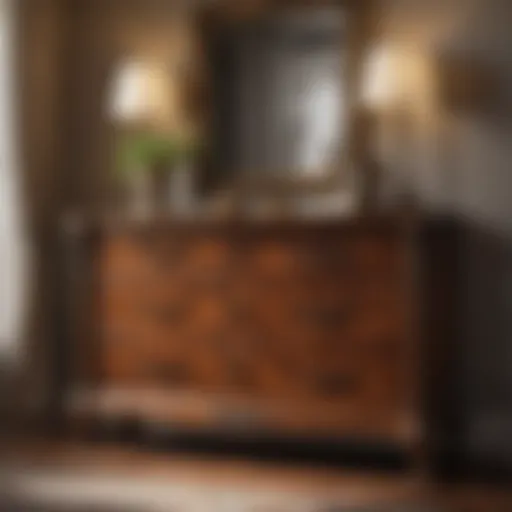The Practicality and Aesthetics of Small Bath Mats
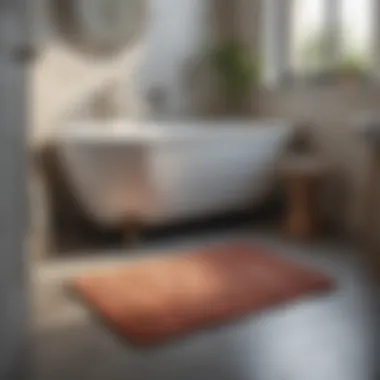
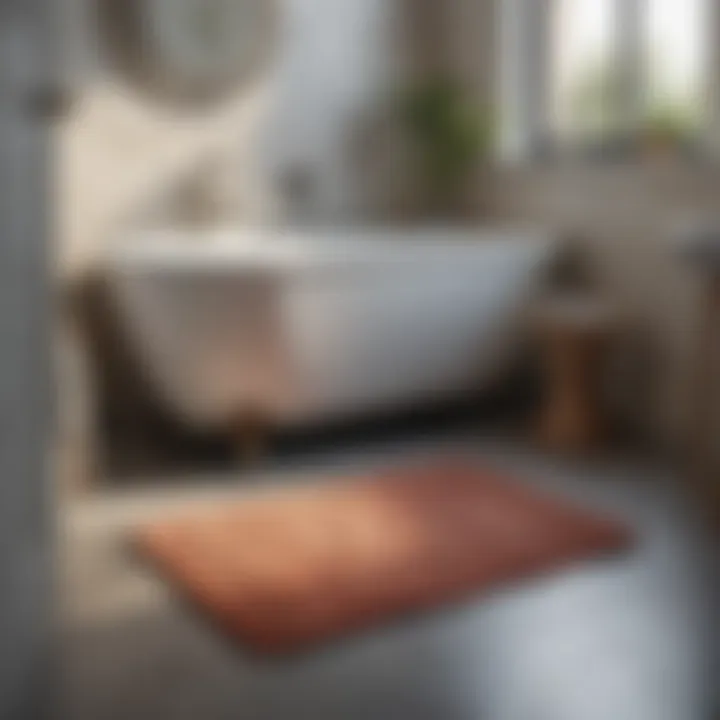
Intro
Small bath mats serve as more than mere accessories within a bathroom setting. They dwell at the intersection of functionality and aesthetics, catering to both practical needs and design preferences. Such mats are not just surfaces to absorb water—they bring comfort, warmth, and an element of style that can influence the overall ambiance of the room. Through an exploration of their qualities, materials, and design aspects, we can uncover how the right small bath mat can harmonize with both functionality and aesthetic demands.
Materials:
To embark on your DIY project for creating a small bath mat, precise planning and material selection are crucial. Below is a concise list of materials you will need, including exact measurements where applicable:
- Soft absorbent fabric (e.g., cotton, microfiber): 1 yard.
- Non-slip backing (e.g., rubberized fabric or a pre-purchased non-slip mat): 1 yard.
- Thread: 1 spool suitable for your fabric color.
- Crafting scissors: 1 pair.
- Sewing machine (or needle if hand-sewing).
- Measuring tape: 1 piece.
- Tailor's chalk or fabric marker: 1 stick
- Pins: 20
DIY Steps:
Creating your small bath mat involves clear guidance. Follow these steps for a successful project:
- Selection of Fabric: Choose soft, absorbent fabric that fits your style. Aim for a texture that is comfy on bare feet.
- Measurement and Cutting: Use the measuring tape to define dimensions you desire, commonly around 20 x 30 inches. Mark with chalk and cut the fabric.
- Prepare Non-Slip Backing: Cut the non-slip backing to the same dimensions as your fabric.
- Pinning Layers: Layer your fabric on top of the non-slip backing. Pin them together to avoid shifting.
- Sewing: Using your sewing machine, sew all edges, leaving a small gap to turn the mat inside out. Make sure to secure corners well.
- Finishing Up: Turn the mat inside out using the gap. Sew the gap shut securely.
Technical Aspects:
To elevate your DIY experiences:
- Ensure Proper Timing: Allocate around 2-3 hours for the entire process from design to completion.
- Critical Techniques:
- Tools You May Need:
- Use double stitching to reinforce edges.
- Pre-wash your fabrics to prevent cloth from shrinking.
- Iron (for smoothing out fabric), depending on the textures chosen.
- Fabric glue (if needed, to secure edges further).
DIY project Process:
Follow this sequential approach for a foolproof installation:
- Evaluate your space and choose the combatible design based on aesthetic needs.
- Ensure the mat sizing fits the intended location—comfy space in front of the sink is ideal.
- Carefully position mats in place—adjust to balance doors' openings and entrances, avoiding tripping hazards.
Troubleshooting Tips:
While working on your mat, some issues may arise. Here are solutions:
- If the layers shift, add extra pins before sewing.
- For uneven edges, trim for neatness once assembly is completed.
- Use non-slip adhesive rug tabs if the mat slides after installation.
Using these instructions thoughtfully, the modest endeavor of creating a small bath mat can lead to both functional and stylistic gains in your living space.
Prologue to Small Bath Mats
Small bath mats serve as a critical intersection of functionality and design within the bathroom space. Their significance extends beyond mere aesthetic improvement; these mats contribute practical features that enhance safety and comfort. Indeed, it is essential to recognize their multifaceted roles in everyday life and their influence on personal and cultural aesthetics.
In the following sections we will explore the multitude of dimensions that characterize small bath mats, revealing both their undeniable utility and their ability to subtly define aesthetics within the bathroom. By understanding the scope and significance of these everyday items, homeowners and decorators alike can make informed decisions that harmonize their choices with both linear design and personal style considerations.
Definition and Purpose
A small bath mat, primarily positioned outside of showers or baths, assumes the responsibility of absorbing moisture and providing a slip-resistant surface. Typically made from a variety of materials, these mats serve to keep floors dry, thus reducing chances for accidents caused by slippery conditions. Furthermore, they offer a tactile and visual comfort, elevating the space with textural diversity and color.
Notably, the design can vary significantly – it can be simple, elegant, or richly textured, depending on the desired aesthetic outcome. In essence, the small bath mat embodies the blend of care for personal safety and an affirmation of personal style judgments in soft furnishing choices. It regulates comfort while simultaneously serving as a welcome catalyst for achieving a particular theme, making it a staple in bathroom design.
Historical Context
Historically, bath mats have evolved significantly, mirroring social trends and material advances. Originally, most bathrooms did not include mats. They gained massive popularity in the late 20th century, at a time when hygiene and wellness became focal points of domesticity. Synthetic materials emerged, enabling manufacturers to create slip-resistant and absorbent bath mats suited to diverse decor styles.
In addition, environmental consciousness has increasingly impacted decision-making in the realm of animal and natural fiber mat production. Homemade solutions also grew common, integrating more easily into existing aesthetics, especially during times of economic turmoil when many turned to do-it-yourself alternatives. The small bath mat's trajectory are thus heavily swayed by societal shifts but remain a requisite for modern bathrooms.'
Benefits of Small Bath Mats
Small bath mats serve vital functions beyond mere decoration. They hold importance both in skin safety and design coherence within your spaces. Choosing the right bath mat greatly impacts the overall utility and beauty of your bathroom. This section explores the functional advantages and aesthetic contributions of small bath mats, detailing why they are essential.
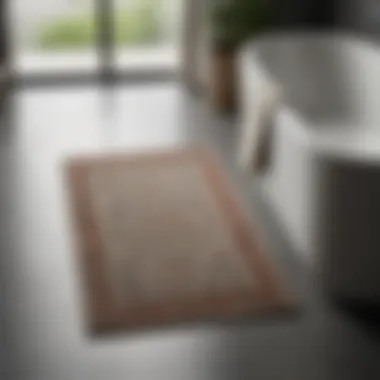
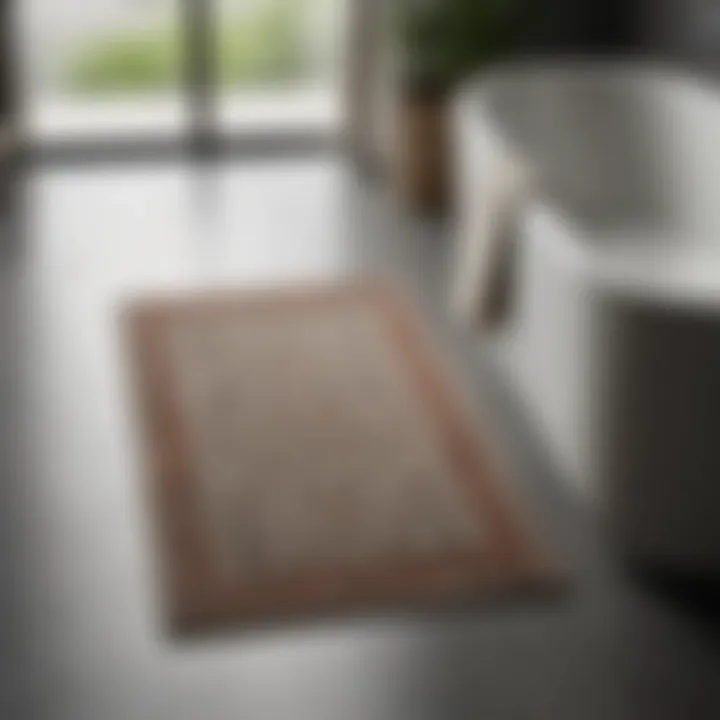
Functional Advantages
Safety and Slip Resistance
One of the main benefits related to small bath mats is their safety and slip resistance. A good mat enhances traction on wet surfaces. This is critical in areas that often become slippery after a bath or shower. Consider textures that provide grip. Materials such as rubber or anti-slip backing help prevent accidents.
The key characteristic of safety-focused bath mats lies in their ability to absorb water quickly and reduce slippery conditions. As you step out of the shower, knowing you are on a secure, slip-resistant surface enables confidence. This makes it a popular choice, promoting safe environments for children and elderly family members, both of whom are often more at risk for falls.
Adding to this, water-dispersing designs can eliminate puddles from forming. These mats play a proactive role in bathroom safety.
Water Absorption
Another essential function is water absorption. After showering or bathing, having a mat that efficiently absorbs moisture keeps the floor drier and reduces water damage to underlying surfaces. Some mats are exceptionally designed with materials aimed at quick moisture retention. This property is significant in maintaining dry conditions in the bathing area.
Water-absorbent materials, like cotton or microfiber, are highly effective. Plus, these materials dry fast, minimizing mold or mildew growth—something every homeowner wants to avoid.
However, if not properly managed, inadequately absorbent mats can lead to unpleasant odors, and loss of one their benefits. Selecting high-quality mats ensures you're getting effective water absorption which enhances both comfort and cleanliness.
Aesthetic Contributions
Increasing Visual Appeal
When you consider aesthetics, small bath mats offer significant visual appeal as well. Whether solid colors or patterned designs, these mats can elevate the overall look of your bathroom. Choose colors that complement existing decor for a seamless vibe.
The unique feature in design is how versatile they are. For instance, a boldly colored mat can serve as a focal point, creating interest in an otherwise monochrome space. They contribute a visual element that small, humble items often contribute heavily undervalued.
While it's vital to embrace styles you enjoy personally, paying attention to color theory may transform a bathroom atmosphere too.
Completing Bathroom Themes
Finally, small bath mats play a key role in completing bathroom themes. Every element of your bathroom design ties together, and elements like rugs enhance this unity. By ensuring a match with towels and accessories, cohesive themes emerge.
The advantage of holistic themes lies in how they create harmony across visual and practical elements. A well-chosen mat becomes not merely a utility item, but a deliberate part of design that users selected thoughtfully. People may underestimate the power of strategical coordination, yet bath mats can be essential partners in that aim.
In essence, thoughtful selection combines utility and impression effectively, guiding favorable perceptions of a person’s or family’s living space.
Materials Used in Small Bath Mats
When selecting a small bath mat, the material is a crucial factor that greatly influences its performance, comfort, and look. Different options suit unique needs, providing various benefits to cater to diverse lifestyles and preferences. Understanding these materials allows homeowners to make an informed decision while ensuring both practicality and aesthetics in their bathrooms.
Cotton
Cotton remains a popular choice due to its natural properties. As a highly absorbent fiber, cotton efficiently soaks up water, which helps keep the bathroom floor dry and reduces slip hazards. It is soft and cozy underfoot, offering comfort that many users appreciate.
The weaving techniques also affect the texture and durability. For example, looped cotton mats provide longevity bettter than flat weaves. However, users must be mindful of maintenance; cotton mats tend to require regular washing to keep stains and odors at bay. The environmental impact is also a consideration, as organic cotton options exist for those prioritizing sustainability.
Microfiber
Microfiber is fine and plush, giving a different feel compared to cotton. This material works exceptionally well for water absorption. Microfiber is synthetic and lightweight, making the mat easy to dry quickly after washing. Furthermore, it resists staining, decreasing the frequency of cleaning required.
While microfiber offers comfort and functionality, it is essential to recall that this material may not have the same eco-friendly credentials as natural fibers. Homeowners should weigh these factors to decide the trade-off based on their lifestyle preferences and values.
Memory Foam
Memory foam presents a unique set of benefits. This material adapts to the shape of the user's foot, providing excellent support. It enhances comfort significantly, especially in minimalist spaces where comfort is often sacrificed for aesthetics. Additionally, it offers superior durability compared to regular foam.
Yet, these mats tend to be pricier. On top of this, care could be more demanding than cotton or microfiber. Specific requirements for washing and drying could limit usability in homes with heavy moisture. Nonetheless, if budget permits, memory foam may elevate the comfort of the bathroom experience.
Synthetic Fibers
Lastly, synthetic fibers, such as nylon or polyester, serve as highly resilient options. These mats often offer increased durability, making them ideal for households with heavy foot traffic. Prices tend to be reasonable, making them accessible for everyone.
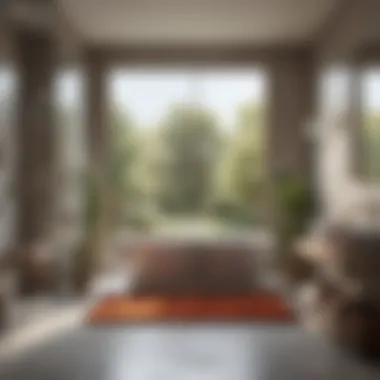

While synthetic fibers provide benefits, their ecological impact cannot be ignored. Homeowners aiming for a sustainable choice should carefully explore brands offering recycled options. Additionally, the ventilation qualities vary among different types, which can influence moisture management in humid bathrooms. Choosing the right fiber balances practicality with aesthetic value, tailored to the homeowner's needs.
Selecting the best material for a small bath mat can significantly enhance safety and comfort while adding to the overall design of a bathroom.
Styles and Designs of Small Bath Mats
Styles and designs of small bath mats are crucial in both enhancing the functionality of your bathroom and conveying your aesthetic preferences. A small bath mat does not only provide a cushioned surface to step on after bathing but also sets the tone for your bathroom’s decor. Thus, selecting the right design element can profoundly impact visual leisurely aspects and overall practicality.
Classic Solid Colors
Classic solid colors are a timeless option for small bath mats. These mats bring elegance and simplicity. They can be paired with nearly any bathroom setup, promoting versatility. Solid colors, like deep navy or soft beige, offer not just unified appearance, but also easy matching with towels and curtains, giving a sleek cooridinated look.
Moreover, they are less likely to show wear and stains compared to patterns, making them a low-maintenance choice. However, lacking pronounced visual interest can detract from bathrooms longing for flair. Thus, while classic colors are practical, they may lack excitement for some.
Patterns and Textures
Geometric Designs
Geometric designs discussion as it applies particularly in modern bath mat styles includes structured shapes like triangles, squares, and lines. These combinations create a dynamic and interesting foundation but expose the interplay of graphic clean lines in a subtly elevated way. People tend to favour geometrical patterns due to their versatility and can enhance contemporary decor by introducing a pop without overwhelming your space.
Patterns seamlessly transition through multiple design schemes, adding creativity without leaving you matched like a cardboard cut-out horror. Though charming, they should be chosen carefully as they can dominate semiporial hues or intricate details of surrounding decor.
Geometric mats can sometimes pose a design dilemma, in rooms with complex themes or high textures. Depending on color choice, contrasts may appear disheveled if too many patterns establish improper balance.
Floral Patterns
Floral patterns also holds unique qualities deserving recognition. They introduce whimsy and fresh vibrancy to rather sterile or minimalist bathrooms. Common motifs may include extravagant blossoms, abstract interpretations, or subtle stylized shapes. This offer welcome contrast against the often rigid nature of geometric styles. Using such patterns often elevates overall ambiance to feeling more inviting.
However, depending heavily on soft pastels can run the risk of rendering some spaces feminine-oriented. Entry mat's intricate details can also make scrubbing the surface to avoid griming a task be the hindrance few might choose ornate florals. Balancing intricacy against superb function safeguarding users is paramount when choosing.
Maintenance and Care
Maintenance and care of small bath mats is significant in preserving their functionality, aesthetics, and longevity. A well-kept bath mat contributes to safety, combats odors, and extends its time of use. Proper attention to these aspects not only ensures a pleasant user experience but also enhances the visual appeal of the bathroom.
Cleaning Recommendations
Regular cleaning of small bath mats is essential to remove dirt and prevent mildew. Here are some solid tips to guide your cleaning process:
- Washing Method: Generally, most cotton and microfiber mats are machine washable. Aim for warm water and a mild detergent. Avoid bleach as it can weaken fibers.
- Frequency: It is recommended to wash bath mats every one to two weeks, depending on usage.
- Air Drying: To maintain the shape and texture, air drying is preferred over machine drying. If using a dryer, opt for low heat to prevent damage.
- Spot Cleaning: For minor stains, immediate spot cleaning is beneficial. Use a damp cloth with mild soap and rub gently.
Regular cleaning helps preserve the color and feel of the mat while also eliminating unwanted odors.
Drying and Storage Tips
The drying and storage aspects of small bath mats need particular attention to avoid moisture build-up:
- Drying Technique: Always lay the mat flat to dry to prevent warped shape. Hanging can cause the edges to curl or twisting to occur.
- Drying Environment: Choose a well-ventilated area for drying to speed up the process. Sunlight can be beneficial, but prolonged exposure may fade colors.
- Storing When Not in Use: If the mat is not used for long periods, proper storage is key. Roll the mat loosely rather than folding to avoid permanent creases.
- Check for Mold: Before storing, ensure the mat is fully dry to prevent mold growth, which may render it unusable.
Following these practices can contribute significantly to maintaining the practical and aesthetic qualities of small bath mats, ensuring they remain a functional asset in your bathroom for years to come.
Selecting the Right Small Bath Mat
Choosing the right small bath mat is critical because it serves both functional and aesthetic purposes in the bathroom. A mat should not only enhance safety but also contribute positively to the overall decor. Getting the right mat involves considering various important elements including size, material, and design.
Considerations for Size
When selecting a small bath mat, size is an essential factor to consider. A mat that is too small may fail to provide sufficient coverage or slip resistance while one that is too large could overcrowd the space, making it appear cramped. Here are a few points to consider:
- Measure Your Space: Before making a purchase, accurately measure the area where the bath mat will be placed. This allows you to understand the dimensions that will fit comfortably.
- Placement Y: Think about where the mat will be used—by the sink, tub, or shower. Different areas have different space constraints, so consider the mat's placement direction.
- Depth and Thickness: A smaller, thicker mat may suit a minimalistic space where comfort is prioritized, while a flat mat might better complement a more ornate bathroom layout.
Incorporating these sizing factors will enhance functionality significantly.
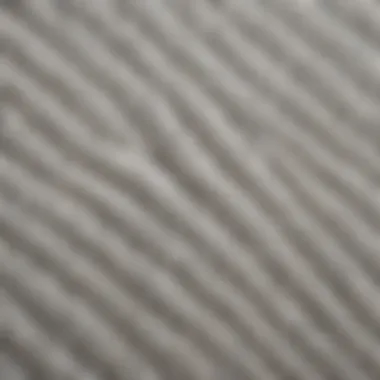
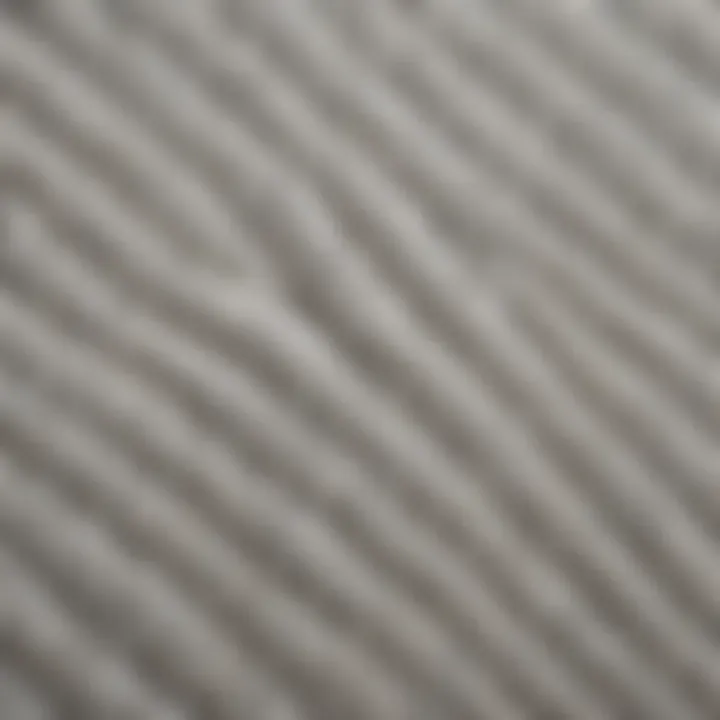
Matching with Bathroom Decor
The next significant aspect when selecting a small bath mat is ensuring it aligns well with the existing decor. A well-chosen mat can act as an integral component of the bathroom’s overall aesthetic. Here are some specific considerations:
- Color Coordination: Look for colors that complement or contrast effectively with your bathroom hues. For instance, a soft blue mat can invoke a relaxing vibe in a predominantly neutral-colored space.
- Style Harmony: Incorporating mats that match your existing style, whether it's rustic, modern, or eclectic, can create a cohesive look. A fluffy retro-inspired mat, for instance, umm might look disrupting in a sleek contemporary setting.
- Textures and Patterns: Different textures can add depth while patterns can serve as focal points. Solid colors often blend in, while bold patterns can demand attention and create a sense of vibrancy.
A small bath mat selected wisely mingles practicality with decor, enhancing both safety and visual appeal in your bathroom.
By narrowing down options based on size and aesthetic considerations, homeowners can ensure their bath mats contribute positively to their spaces, reflecting their style and serving necessary functions adequately.
Common Misconceptions About Small Bath Mats
The topic of common misconceptions about small bath mats may seem trivial at first, but it is crucial to address these misunderstandings. Many housewives and homeowners may perceive small bath mats not fully realizing their versatility and role in both practicality and aesthetics. This section aims to clarify these misconceptions, highlight the importance of durability, and discuss how cost can relate to quality.
Durability Issues
A frequent concern many people have is whether small bath mats are durable enough for everyday use. Often, individuals question the longevity of these mats, contemplating if they can withstand regular wear and tear in high-traffic areas of the bathroom. In general, bath mats made from sturdy materials like high-quality cotton or synthetic fibers are designed to endure moisture, foot traffic, and washing.
It's necessary to note that while price may imply some level of durability, not all affordable options compromise quality. Many economical brands utilize advanced manufacturing processes to ensure that even budget mats maintain a satisfactory lifespan. This means that opting for a smaller bath mat for your bathroom doesn't intend a compromise on longevity.
To dispel these durability myths completely, potential buyers should look for product specifications indicating the material's endurance and washability. Careful selection can truly yield a small bath mat that remains functional over the years, even with daily exposure to water.
Cost Versus Quality
Another common misconception surrounds the relationship between cost and quality. It is often falsely believed that for a mat to be of good quality, it must command a high price. However, this idea doesn't always hold true. While premium mats, like those crafted from memory foam, can justify their higher costs due to better comfort and support, there are also competitive mid-range options that perform exceptionally well.
Housewives and homeowners should assess whay they need from their bath mat. Are you primarily seeking absorbency, style, or durability? Consider these factors alongside your budget. Here are some elements to evaluate:
- Material: Different materials impact both quality and price.
- Manufacturing Process: Brand reputation can aid in identifying quality.
- Customer Feedback: Reviews can provide insight into performance and longevity at various price points.
Environmental Impact of Small Bath Mats
The selection of a small bath mat extends beyond personal taste and bathroom aesthetics, especially when considering its environmental impact. Households today are increasingly aware of sustainability issues, and bath mats are no exception. This section explores how making mindful choices can contribute to a healthier environment while maintaining functionality and style in your home.
Sustainable Materials
Sustainable materials are at the forefront of eco-friendly design. Opting for materials that are renewable, recyclable, and biodegradable can significantly reduce an individual’s carbon footprint. Here are some sustainable material options:
- Organic Cotton: Grown without synthetic pesticides or fertilizers, organic cotton mats are both sustainable and absorbent. They decompose well and contribute positively to soil health.
- Bamboo: Fast-growing and renewable, bamboo is an excellent choice for bath mats. Fiber derived from bamboo is soft, durable, and naturally antimicrobial.
- Recycled Fibers: Mats made from recycled plastics or textiles utilize materials that might otherwise end up in landfills. This approach not only reduces waste but reintroduces materials into circulation.
- Natural Fibers: Other materials such as jute or sisal offer bio-degradable options that blend well with a natural decor theme.
Choosing these materials not only helps reduce environmental waste but also enhances the durability of the bath mat, creating longer-lasting products.
Disposal and Recycling
Proper disposal and recycling options for bath mats are critical for minimizing your environmental footprint. Here's what homeowners should consider when it's time to retire an old mat:
- Check for Recycling Programs: Some communities have recycling programs for textiles. Stt the status of such programs could allow bath mats made from certain materials to be repurposed.
- Upcycling Ideas: If the mat is too worn for regular use, it can potentially be used as a pet mat, external doormat, or in crafting projects. This gains a second life for the mat rather than letting it go to waste.
- Compostable Alternatives: For mats created from entirely natural materials, consider composting them instead of disposal in landfills. This choice can return nutrients back to the earth.
In summary, an eco-conscious approach in choosing small bath mats incorporates both sustainable materials and proper disposal. Respecting the relationship between home design and environmental considerations stands as a priority for every conscientious consumer.
Bath mats play a role in maintaining an inviting and functional bathroom environment. Thus, understanding their environmental impact needs to become a standard consideration for homeowners faced with options in small bath mats.
Finale
In summary, the prominence of small bath mats extends beyond mere decorative elements in bathroom spaces. The intersection of practicality and aesthetics presents an opportunity for thoughtful incorporation of these mats into any design scheme. Given their functional attributes such as safety by enhancing slip resistance and water absorption proficiency, small bath mats are critical for daily use following showers or baths.
Summarizing Key Points
- Utility: Small bath mats provide a practical solution in preventing slips while also absorbing moisture. This quality is essential for health and safety in the bathroom environment.
- Design Versatility: Available in various materials, colors, and designs, these mats allow individuals to express personal style without overwhelming the senses. From plush options to sleek and modern designs, there exists a variety to complement any theme comfortably.
- Maintenance: Caring for small bath mats can blend easily into everyday routines. Regular cleaning and proper drying can significantly extend the lifespan of the mat, promoting not only hygiene but also sustainability in the choice of materials.
Future Trends in Bath Mats
As consumer awareness towards ecological choices increases, the future of small bath mats is likely to feature sustainable materials. Brands may focus on organic cotton, bamboo fibers, and recycled plastics to meet rising demand for eco-friendly products. Additionally, technological advances in textile engineering could lead to enhanced functionalities, such as odor resistance or superior absorption capabilities. \nSetting design trends, one foreseeable shift is the movement towards minimalism—fewer patterns and richer, earth-toned colors might take precedence to create a calming sanctuary within the bathroom.
Adapting style to reflect personal values embraces a holistic approach to home decor that astutely considers environmental and aesthetic impacts.
As shoppers remain discerning about quality versus cost, brands must ensure products are durable yet affordable to meet diverse preferences. Overall, ultimately prioritizing practicality in small bath mats leads to harmonious living spaces that satisfy elegant design sensibilities.



